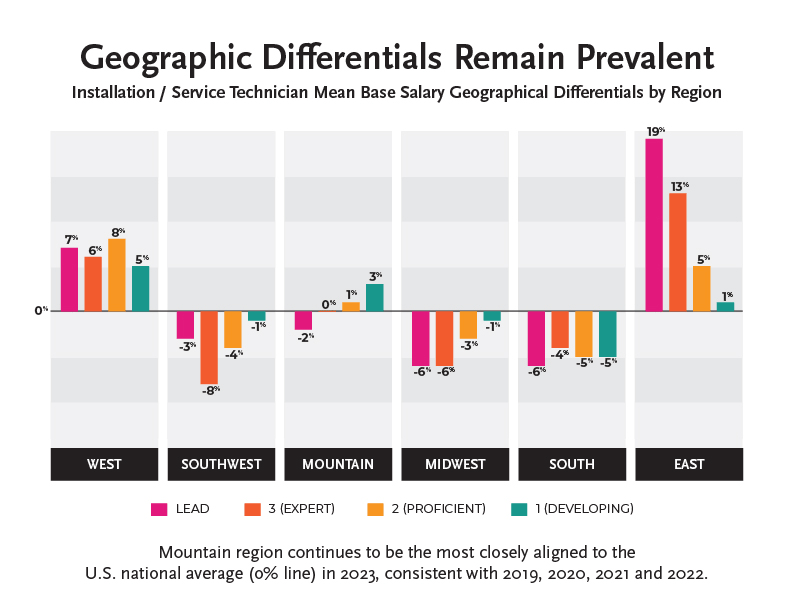
This article was initially published in C2HR’s “Official Newsletter for Members of Content & Connectivity Resources,” Mar 2024 edition.
As permanent remote work becomes more entrenched, the use of geographic pay differentials is gaining traction. C2HR’s Annual Compensation Surveys have long revealed that geographic-based pay is well established among connectivity companies. Content developers are now also offering pay differentials…but gaining employee acceptance can be challenging.
C2HR’s 2023 Connectivity Provider Compensation Survey shows that pay for installation/service technician continues to be highest in the East. A lead service tech makes 19% more than the national average, while a lead technician in the Midwest makes about 6% less than the national average. Base pay for these positions is also consistently higher in the West. (See figure) Depending on the city, the differentials can be even greater.
 “Base pay in some regions, like the San Francisco Bay Area, can be as much as 30% higher than the overall U.S. average with some rural locations as much as 15% to 30% below the U.S. average,” explained Hali Croner, President and CEO of The Croner Company, the research and compensation consulting firm that conducts the annual Compensation Surveys for C2HR.
“Base pay in some regions, like the San Francisco Bay Area, can be as much as 30% higher than the overall U.S. average with some rural locations as much as 15% to 30% below the U.S. average,” explained Hali Croner, President and CEO of The Croner Company, the research and compensation consulting firm that conducts the annual Compensation Surveys for C2HR.
Where Are Remote Workers?
C2HR’s 2023 Compensation Surveys also reveal that the number of permanent remote employees is increasing, although still smaller than hybrid and in-office workers. Among connectivity companies, the highest concentration of remote workers—22%— is located in the Mountain region. These employees tend to work in customer care, dispatch and software engineering.
Permanent remote workers are more geographically dispersed at content developers. The highest concentrations are in the Southwest, 37%; Mountain, 32%; and Midwest, 29%. These employees tend to work in advertising trafficking, advertising sales, information technology and finance.
During the recent planning meetings for the 2024 C2HR Compensation Surveys, content developers revealed challenges related to geographic differentials. In today’s competitive climate for talent, some job candidates are not receptive to geographic pay, and existing employees moving to lower pay markets don’t want to see their salaries reduced.
Croner recommends that companies explain how geographic differentials help ensure pay equity. “If your policy is to pay the median wage in each labor market, then that helps your company ensure it is paying employees the same way, regardless of location,” she said.
She continued: “While it is true that the gap of cost of labor and cost of living aren’t always the same in each location, the use of cost of labor in each location also ensures that there is a consistent and equitable approach. We would also remind companies from a business perspective that cost of labor does still vary, and many businesses choose to set up in places where cost of labor can support their financial goals.”
Some of this resistance may also be a result of in-flux policies during the pandemic. “There appears to be a difference in policy for employees who moved away from the office in the pandemic years and now when the combination of modalities is in a more steady state,” Croner added. “Employees who are permitted to work on a permanent remote basis now likely are subject to more well-defined policies and approaches to geographic pay of their employers.”
 |
RELATED RESOURCES |

